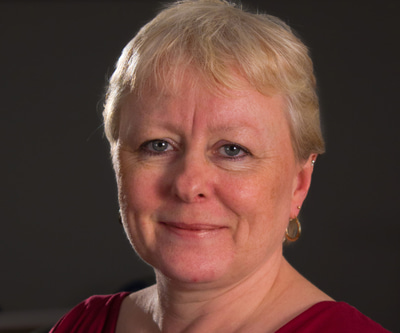- OT
- Life in practice
- Practitioner stories
- Coronavirus: on the ground in Essex
Coronavirus: on the ground in Essex
Emma Spofforth on the challenges of shielding as an optometrist: “It did sadden me that my skills were not going to be used”

25 August 2020
In a nutshell
Location: Essex
Years qualified: 32
Mode of practice: Optometrist and Essex Local Optical Committee Secretary
My practice is in South Essex but I live in London. During the lockdown, I was not seeing patients face-to-face because I was shielding. When the pandemic started, the main thing that we did as a Local Optical Committee (LOC) was to disseminate information. Practices were struggling to siphon off useful information from all of the news that was coming through. We distributed snapshots of relevant information and uploaded coronavirus (COVID-19) content to our LOC website.
It is essential to give clear and concise information to practices. We endeavoured to make sure that the right information got to the right people at the right time. We wanted to keep our practitioners and our patients safe.
We were aware that we needed better communication with the hospitals. We have five hospitals that we refer to in this region. As an LOC, we double-checked exactly what each hospital wanted regarding referrals. We have used technology, such as Attend Anywhere, to allow practices to safely and securely communicate with hospitals about patients. We have been able to accommodate repeat readings for IOPs, fields and OCT, to help out the hospitals’ current patient backlogs. We also helped triage some referral backlogs to see who could be seen in the community after all.
I think a lot of practices are having to make decisions about which bills to pay. Practices can’t just survive on NHS sight test fees – that won’t keep most practices afloat. Several practices are now actively reducing or stopping their GOS contracts.
One hospital set up an advice and guidance process via WhatsApp very early on in the pandemic. We were given specific contact information for the main emergency eye care ophthalmologist, who responds even at times when the eye department is closed. That was really good and has been expanded to another hospital in the region.
In the past, optometrists would send a patient in if they were not sure. What we can do now is contact an ophthalmologist directly if we are uncertain whether to refer. The ophthalmologist might say ‘Actually that is fine; all you need to do is this treatment.’ We are now looking at setting up more secure advice and guidance using the Pando app across the whole region.
In the early days, many practices did not know whether to stay open, to close, or what risks to take. We spent time discussing issues like this with practices. The contractors did not know what to do because they were not getting guidance from NHS England.
We discovered new ways of holding meetings via Zoom and Teams. Out of necessity, we had to run many more meetings in the virtual world, but it was much easier than I thought it would be. By running LOC meetings and the annual general meeting via Zoom, the LOC saved a lot of money.
As well as engaging with practices and the hospitals, we were in regular contact with the seven Clinical Commissioning Groups (CCGs) in our area. We are lucky to have Minor Eye Condition Services commissioned in all of our regions before COVID-19 struck - including the use of FP10s in part of the region. We have had success expanding the inclusion criteria for the community services following the release of the COVID-19 urgent eye care service (CUES).
I spent most of one week trying to access the national personal protective equipment (PPE) supply chain. We were able to get “free” PPE for all the optical practices continuing to provide emergency and essential care from the CCGs.
One of the common concerns I heard from practices during lockdown was around PPE. Sourcing PPE was a massive issue for practices early on and many optometrists did feel like they were taking their lives into their hands. We were hearing about the death rates and, as it is a close contact profession, many optometrists felt at risk.

Another big worry for practices is how their businesses will survive going forward. Most practices had furloughed the majority of their staff and the grants are just enough to keep the wolf from the door. I think a lot of practices are having to make decisions about which bills to pay. Practices can’t just survive on NHS sight test fees – that won’t keep most practices afloat. Several practices are now actively reducing or stopping their GOS contracts.
Many patients still do see spectacles as an extravagant purchase. Practices are also concerned about how to process patient flow. If we have to have social distancing for some time, we will have to do things in a much more controlled manner with fewer patients coming through the door. The loss of daily patient numbers is a concern for many practices.
The personal impact: “As things quieten down, the lack of human contact might become more of a strain”

I was so busy with my Local Optical Committee work, that I didn't have time to get bored during lockdown. At least I had my dog Obi (pictured) to keep me company, although he did miss coming in to work with me.
For optometrists, there is a worry that we are high risk because of how close we get to patients. We now work in a different landscape. Optometrists have had to reassess how they see patients – down to the clothing they wear as well as the PPE. Many now wear scrubs and struggle with the misting of equipment due to wearing masks and visors. There is now extra time required for cleaning and disinfecting. The eye examination takes a lot longer, even with ongoing help from ancillary staff.
I don’t see myself going back into practice for a considerable amount of time. I want to carry on seeing patients because that is what I trained for. It is what I have been doing for the last 30 years. It does sadden me that my skills are not going to be used. I’m looking at ways I can be part of the remote consultations many optometrists are now having to undertake. We need to have a dynamic and innovative approach to eye examinations going forward.
• As told to Selina Powell.
Advertisement


Comments (0)
You must be logged in to join the discussion. Log in